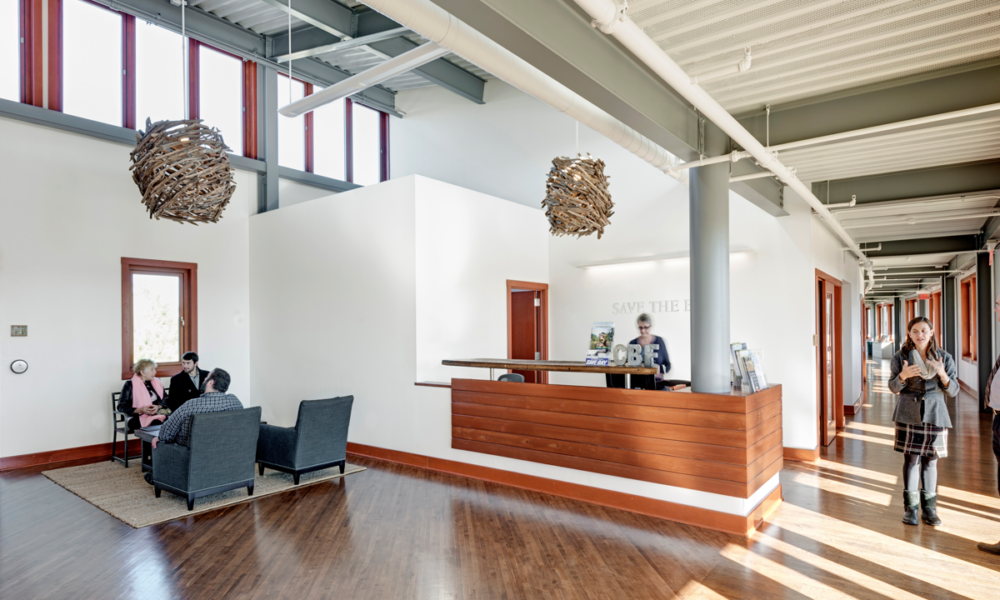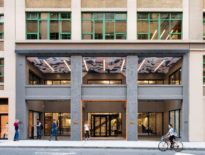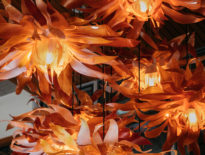This is an excerpt from Juliet Grable’s Brock Environmental Center for a Living Chesapeake.
DESIGNING WITH NATURE
The Living Building Challenge Standard mandates the incorporation of biophilic elements into the design of buildings in order to nurture the innate human attraction to natural systems and processes. The ILFI considers this natural connection essential to physical health and mental well-being. Much like the human tropism toward beauty, this intuitively felt truth has been ignored too often in modern architecture. Recognition of biophilia, or the inherent human affinity for our natural world, was a part of the Brock Center design from the earliest sketches right up to the time when the final coats of paint were applied. For guidance, the design team paid heed to Dr. Stephen R. Kellert’s Six Principles of Biophilic Design. Although it is easy to experience the elegant natural design elements of the Brock Center and intuit that it is informed by the philosophy of biophilia, it is also possible to identify specific features by Kellert’s biophilic design categories:
ENVIRONMENTAL FEATURES:
Elements include the use of color and natural materials, and the incorporation and enhancement of views and vistas. Before choosing colors for the building, the design team studied photographs of the site during different seasons. The Brock Center’s palette complements and mimics these natural color schemes, which include the blues of The Chesapeake Bay, the green of Loblolly Pine needles, the straw blond of salt meadow plants, and the rusty orange of resident marsh grasses. Many of the building’s features work together to enhance views and encourage visitors to connect with the landscape. These features include the building’s long form, abundant windows, elevated grade and its orientation on the site.

NATURAL SHAPES AND FORMS:
The Brock Center incorporates natural shapes and forms inside and outside the building, and on the macro and micro scales. The entire building was designed to resemble an animal; in particular, the conference room, with its curved roof, hints at the terrapin’s shell, a gull’s wings, and an oyster’s shell; the overlapping zinc shingles resemble fish scales. The interior vaulted space curves, and the beams recall the curving limbs of live oaks that grow on the site.
NATURAL PATTERNS AND PROCESSES:
This category includes natural patterns on different scales, called fractals, and elements that suggest the passage of time, among others. In the Brock Center, the inward-spiraling pattern in the conference room flooring creates a central focal point and makes a complicated room cohesive. Similarly, the diagonal flooring pattern in the lobby and open office areas help integrate the different parts of the building into a unified whole.
LIGHT AND SPACE:
The many windows, abundant natural light and high ceilings in the office area and conference room create feelings of spaciousness and evoke a natural environment. In contrast, the lower ceilings of the corridor, combined with the continuous curve, direct attention out the windows. The dog trot—essentially an outdoor room within the building mass— serves as a transition space between indoors and outdoors. “The biggest compliment that we get about the building is that it feels so comfortable. Whether that’s because of the choice of paints or the curves, nothing feels sterile or like a ‘normal’ office building. Every aspect of the building has a bit of fun in it.”

HOW IS THE BROCK CENTER LIKE AN OYSTER?
The design team admired the native oyster not just for its pleasing physical form, but for its functions, which are so vital for the health and water quality of The Chesapeake Bay, and which matched many of the goals for how the Brock Center would function. This approach marries biophilia with biomimicry—the practice of taking cues from natural forms and processes to create better buildings, materials, and products that are nontoxic, low energy and do not produce waste. Here are some of the characteristics of oysters that the design team looked to for inspiration:
- Oysters are tolerant organisms, able to withstand wide variations in temperature.
- Oysters provide valuable shelter and habitat for many other estuarine organisms.
- Oysters filter the water and remove sediment, improving water quality.
- Oysters stabilize the bottom and buffer the shoreline from erosion.
- Oysters transform trash into treasure by encapsulating irritants and turning them into pearls. •
- Oysters open and close for protection, responding to environmental conditions.
PLACE-BASED RELATIONSHIPS:
The siting and form of the Brock Center pays close attention to the site. The building’s horizontality reflects the topography, with its low-growing marsh grasses and uninterrupted views of the water and sky, and its gentle curve mimics the shoreline. The Brock Center also pays homage to historic and indigenous structures, including longhouses, which are characterized by their long form, vaulted space, and overall simplicity. The Brock Center also draws from the plantation houses of European settlers, notable for their elevated structure and wrapping porches, and from Southern dog-trot houses, which utilize a central breezeway to unite public and private spaces.
EVOLVED HUMAN-NATURE RELATIONSHIPS:
This final category includes concepts such as prospect and refuge; exploration and discovery; and affection and attachment. The Brock Center addresses many of these functions simultaneously. The physical approach to the Center decouples humans from their cars; the peaceful, forested environment creates a literal physical transition from the fast-paced, car-centric built environment to a slower-paced, more sensual place. The education pavilion serves as a place of prospect and refuge—its roof protects people from the elements but does not cut them off from the smells of the marsh and sounds of the rain. The pavilion also serves as a classroom for CBF’s educational programs—a place that nurtures exploration and discovery.
Purchase your copy of Brock Environmental Center for a Living Chesapeake here.



